There is an old saying that “flat pedals win medals” and Sam Hill is still proving it on the EWS circuit. We don’t have to clip in to find speed and flow, flats have become the new rock’n’roll… But what makes a good flat pedal? In this test, we compared eight exciting models for you.
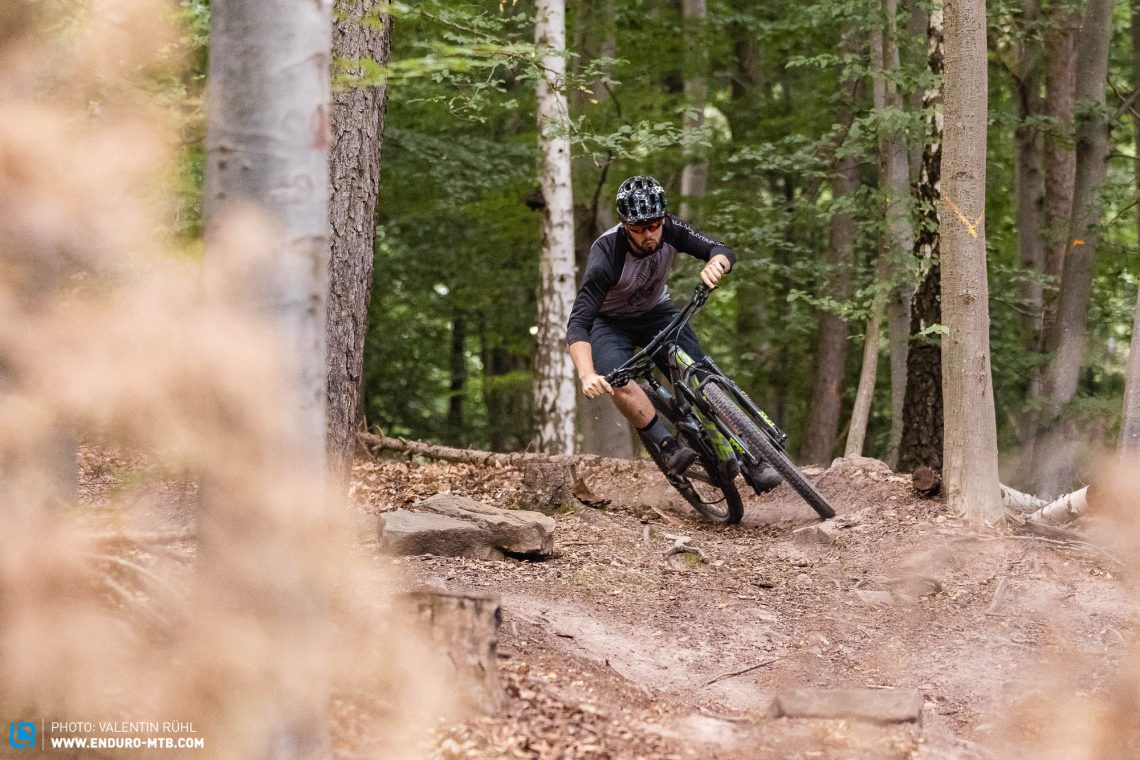
The test field
Most riders will find the flats in this group-test a very interesting option: they all offer interchangeable pins, high-quality bearings and lots of grip — and all of this at a reasonable and affordable price. All of the pedals spin on reliable chromoly axles and retail at prices ranging between € 80 to € 150. In order to push the pedals to their limits we tested them in a number of different scenarios: from regular after-work rides on our home trails to shuttle-assisted gravity sessions, long days at the dirt-jump track and even an epic Alpine crossing. Flat pedals are very versatile and that’s why we picked models which can perform well in any sort of discipline. All of the models in our test come with a platform size of around 100 x 100 x 15 mm. The only outliers in the group are the OneUp Components Aluminum pedals with a 115 x 105 x 10 mm and the ACROS A-FLAT MD with 100 x 98 x 18 mm sized platform. As far as the number of pins goes we weren’t interested in anything with less than eight pins per side. With a whopping 11 pins per side, the DMR Vault is clearly ahead of the competition closely followed by the evergreen Hope F20, Reverse Black ONE, Nukeproof Horizon and Crankbrothers Stamp 7 with 10 pins and the SPANK OOZY TRAIL with 9 pins per side.
| Pedal | Platform size in mm (L x W x H) | Pins per side | Weight | Price |
|---|---|---|---|---|
| ACROS A-FLAT MD | 100 x 98 x 18 | 8 | 353 g | € 74.95 |
| Crankbrothers Stamp 7 | 100 x 100 x 11-13 | 10 | 350 g | € 150 |
| DMR Vault | 105 x 105 x 17 | 11 | 428 g | € 130 |
| Hope F20 | 110 x 102 x 15 | 10 | 393 g | € 155 |
| Nukeproof Horizon Pro | 100 x 100 x 17 | 10 | 420 g | € 104.99 |
| OneUp Components Aluminum Pedals | 115 x 105 x 8,3 – 12 | 10 | 368 g | $ 125 |
| Reverse Black One | 100 x 100 x 14,5 | 10 | 313 g | € 120 |
| SPANK OOZY TRAIL | 100 x 100 x 12 | 9 | 365 g | € 135 |
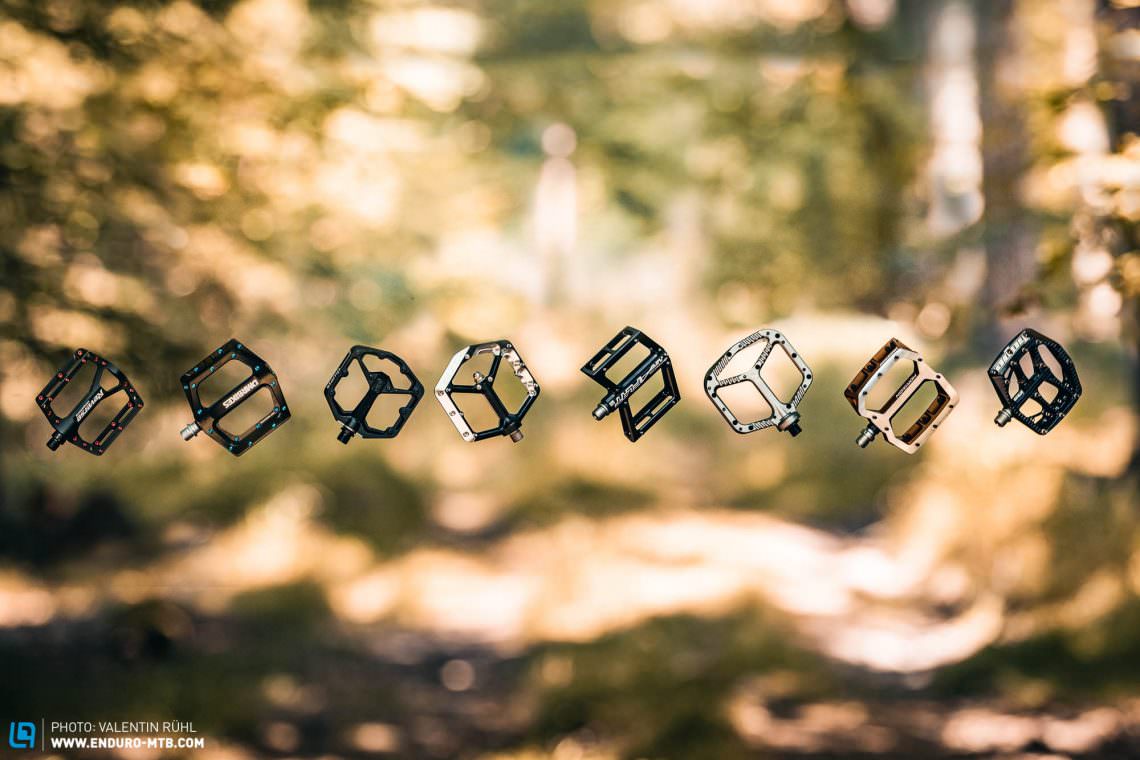
What makes a good flat pedal?
What is essential for good grip on flat pedals? The pins of course. However, it is a common misconception that the number of pins is the only decisive factor to determine the grip of a flat pedal. In reality, the arrangement, size and surface of the pins are even more important. Chunky and long pins with a rough surface offer significantly more grip than smooth pins or an excessive number of them. The platform is another essential criterion. First off it’s important that the platform fits your shoe size to ensure a secure footing and sufficient ground clearance. Pedals with large bearings or heavily curved platforms can prevent the pins from digging into the sole of your shoes properly — this can be a problem if the foot won’t sit on the pedal properly.

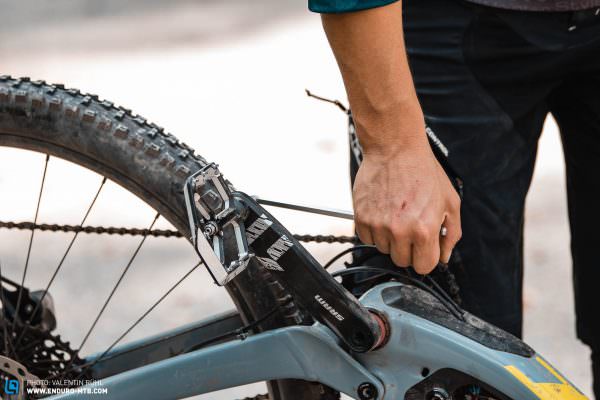
But where’s the point in having excellent grip if you struggle to quickly reposition your foot when you really need it? Pedals like the Nukeproof Horizon Pro or DMR Vault provide so much traction that it can be difficult to adjust the position of your foot on the pedal. The Hope F20 offers the best compromise between maximum grip and adjustment freedom and its conical pins allow you to move your foot without losing grip.

If the pins are too thin they will stir inside the soft rubber of your soles like a kitchen mixer in a bowl full of dough.
One last important and probably the most underestimated attribute for a good flat pedal is its mud-shedding qualities. When riding dry summer trails this is absolutely irrelevant but once the wet season takes over even the dustiest trails turn into a mud-fest. And when your pedal clogs up with mud even the longest pins won’t do. An open platform design and lots of cutouts will prevent the mud from damaging your pedals.
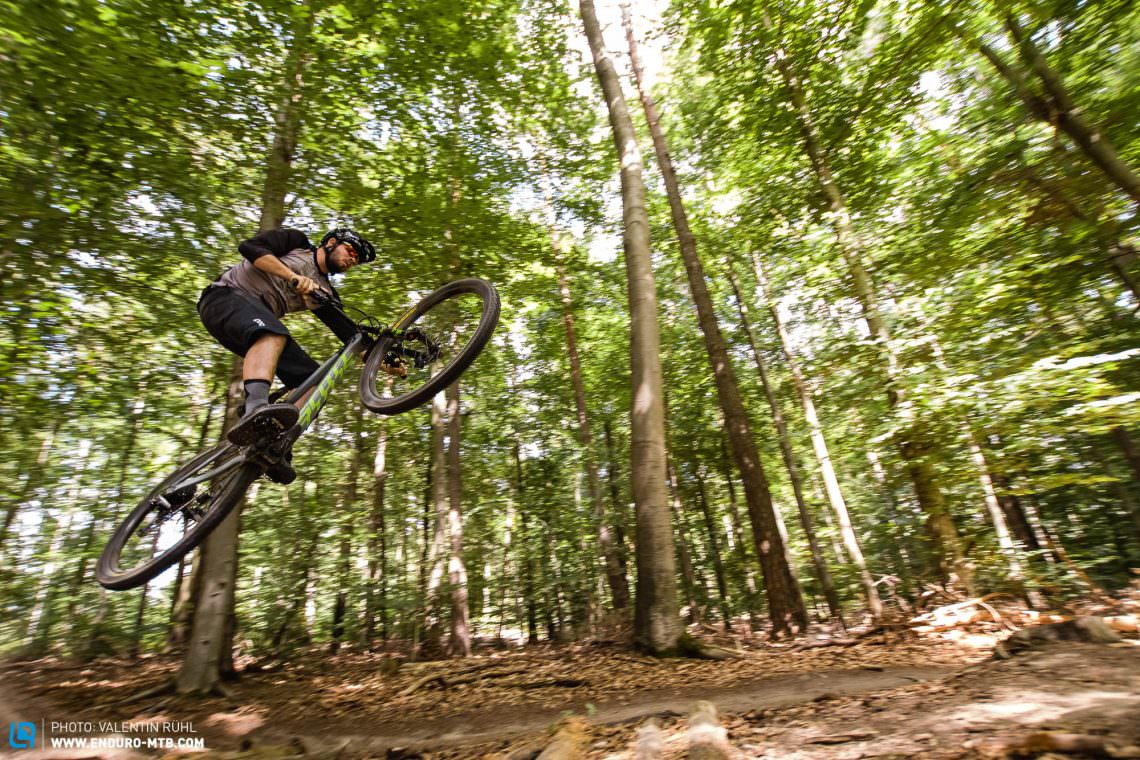
Maintenance
Everybody needs a little love in their lives, even your pedals! The easiest and most effective way to enjoy your flat pedals for a long time is to clean them regularly. In addition, we recommend a yearly service which consists in cleaning and re-greasing the bearings. Most manufacturers rely on a combination of bushings and ball-bearings to achieve an optimal compromise between shock resistance, platform clearance, pedal weight and price. You can get a special service-kit with all important bearings for all of the pedals in this test.
If you spend lots of time riding on Alpine terrain and you’re likely to repeatedly smash your pedals into rocks you really want to make sure the pins of your pedals can be taken off and replaced easily even when they’re totally destroyed. In our test the only model that allows you to do this is the Hope F20: the hollow pins can be turned inside out which means that the state of the pins is irrelevant and that the screw heads remain undamaged.
Tops & Flops
Tops
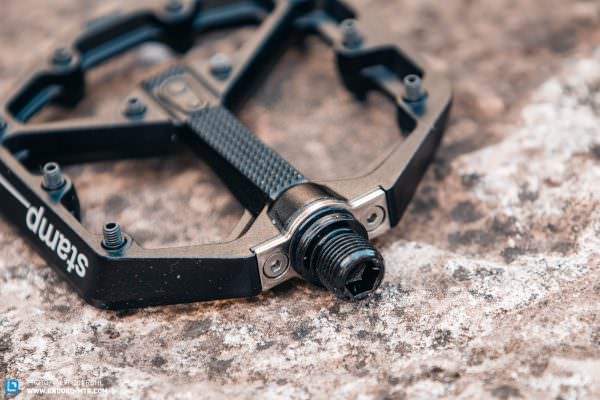
The pin grease port of the Stamp 7 allows you to re-grease the bearings when needed
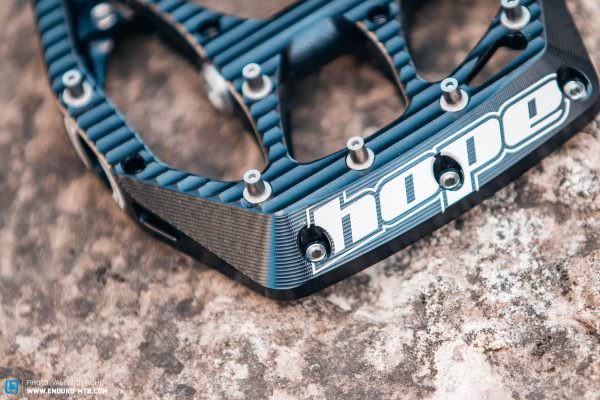
Even just aesthetically the Hope F20 would be the clear test winner
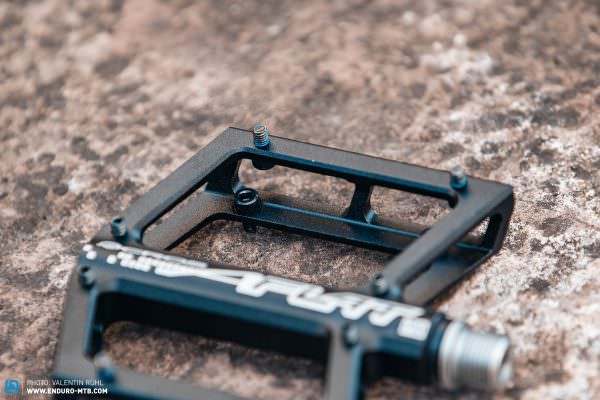
The loctite on the pin-threads makes sure the pins won’t go anywhere

The pins of the Nukeproof Horizon Pro would make Freddie Kruger toes curl
Flops

The huge inboard bearing of the OneUp is really annoying on long pedalling sections
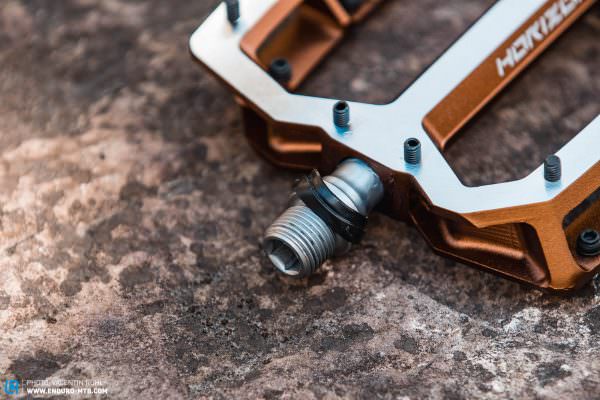
High-end bearings with low-end seals on the Horizon Pro
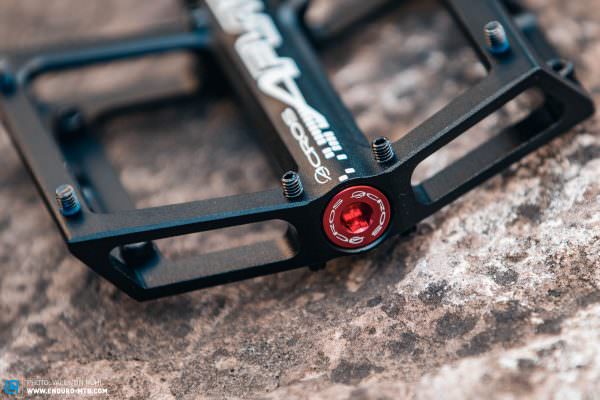
Depending on their state worn out pins can be hard or even impossible to remove

The closed platform design of the Hope F20 is not ideal for mud shedding
Conclusions
None of the pedals failed the test. All models offer sufficient grip for hard enduro-riding as well as for epic alpine missions and dirt-jump sessions. But at the end of the day there can only be one winner and upon closer inspection, the differences between the pedals became more evident. The Reverse Black ONE might well be the lightest model in our test but it simply can’t match the level of traction of the ACROS A-FLAT MD — which only weighs 33 g more. For only € 75 the ACROS A-FLAT offers everything a solid pedal should have — maybe it’s a little on the lean side with its simple body and reduced number of pins (8). For about € 30 more you’ll get Nukeproof’s Horizon Pro pedal which offers the best grip in test and really impressed our test-crew with its slick aesthetics, grabbing the coveted ENDURO “Best Value” tip.
Lots of pins = lots of grip? Not really!
With 11 pins on each side and a price-tag of € 130 the DMR Vault didn’t perform too badly either but unfortunately, it’s too heavy and offers therefore little added value. Both the OneUp and the SPANK OOZY TRAIL convinced our test crew with a thin platform which gives you room for a few extra millimetres of ground clearance when riding through rock gardens. In return, you’ll have to put up with the burly inboard bearing which is guaranteed to get in your way more often than you’d like it to. At the end of the day, the Hope F20 stands out from the crowd with its superb looks, plenty of traction and well-thought-out details such as the hollow pins which can be easily removed even if they’re totally knackered. All of this puts it right at top of our test field and makes it our 2018 ENDURO Best in Test flat pedal.
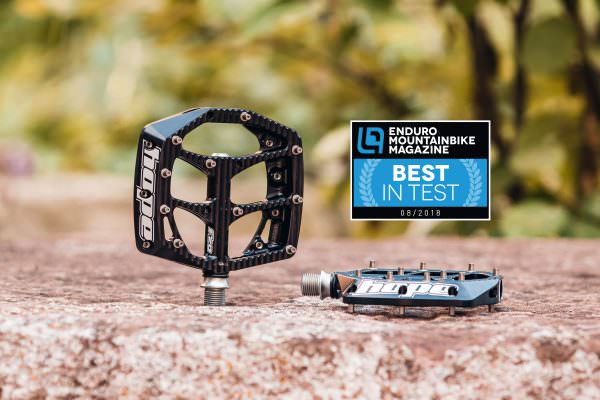

You are not sure whether you should ride clipless or flat pedals? Or you want to know more about our test criteria? Then head to the main article: Contact point no. 1: The best pedals for trail and enduro riders in comparison and check out our clipless pedal group test: The best clipless MTB pedals you can buy









